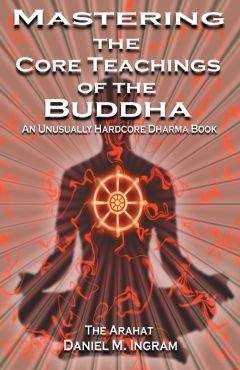Daniel Ingram - Mastering the Core Teachings of Buddha - An Unusually Hardcore Dharma Book
На сайте mybooks.club вы можете бесплатно читать книги онлайн без регистрации, включая Daniel Ingram - Mastering the Core Teachings of Buddha - An Unusually Hardcore Dharma Book. Жанр: Прочее издательство -,. Доступна полная версия книги с кратким содержанием для предварительного ознакомления, аннотацией (предисловием), рецензиями от других читателей и их экспертным мнением.
Кроме того, на сайте mybooks.club вы найдете множество новинок, которые стоит прочитать.

Daniel Ingram - Mastering the Core Teachings of Buddha - An Unusually Hardcore Dharma Book краткое содержание
Mastering the Core Teachings of Buddha - An Unusually Hardcore Dharma Book читать онлайн бесплатно
I often think of the momentum that retreats generate in terms of rolling a boulder over a hill. If you get a long running start, pushing hard the whole way, you are more likely to be able to get the boulder rolling fast enough so that it rolls over the hill in one straight shot. If you push intermittently or half-heartedly, the boulder is likely to roll back when you get to the steep part of the hill, but you have worn the hill down a little bit, and you may also be a bit stronger for the exercise. Thus, it is possible to wear down the hill given enough time, but it is much faster to simply power over it the first time and move on to the next hill. I know of no obvious benefits from slow practice that fails to gain some footholds in the territory of concentration or insight.
Those who take the wear down the hill approach may eventually lose faith and interest, having done lots of work to little effect. Those who really apply themselves and cross a few hills early on through focused and consistent effort, such as retreats or really solid daily life 69
Practical Meditation Considerations
practice, will have more of a sense of accomplishment and
empowerment, and may have even put in less total time and effort than those who tried to wear down the hill. This irony should not be lost on those who want to be smart about developing their meditative skills.
For example, lets say that you could allocate 365 hours out of one year to formal meditation practice. Given a choice, I would be more inclined to take half of those hours, about 182, and do a 10 day retreat practicing hard and consistently 18 hours a day with minimal breaks at the beginning of the year, and then spend half an hour meditating each of the other days. I would be much more likely to cross into some interesting territory early on and overcome some of the initial hurdles than if I spent one hour each day for that year practicing well. The amount of time and effort is the same, but the effect is likely to be quite different.
A few odds and ends about retreats. First, retreats tend to have a semi-predictable rhythm to them. Realizing this allows us, if we have the time and resources to space, to choose how long a retreat we want to meet our meditative goals. Even if we are practicing well, the first few days of a retreat tend to be mostly about adjusting to the place, the posture, the routine, the people, the local customs, the schedule, etc.
Similarly, the last day or two of a retreat tends to bring up thoughts of what we are going to do next. Thus, to give yourself some time in the middle when you are not dealing with these things as much, I recommend greater than 5-day retreats when possible. It is not that benefit can’t be derived from shorter retreats, but there is something about those middle days that tends to make strong concentration and good practice easier to attain.
Second, every retreat center and tradition has its neurotic shadow aspects and downsides. This is inevitable, but by identifying them and realizing that there are ways to have them not slow our investigation down is helpful. One center where I have spent a bit of time is prone to attracting very serious, scowling people who trudge around in their walking practice like the slightest sound or glance from anyone around them might set them off like a bomb. I have been to another center where sometimes I have been the only meditator there, requiring me to have more self motivation and discipline. Another monastic center I 70
Practical Meditation Considerations
have been to has the whole male hierarchy thing going which can cause all sorts of reactions from retreatants both female and male.
Then there are basically always neurotic things around food (huge topic, of which vegetarian vs. non-vegetarian is just the tip of the iceberg), bathrooms, quarters, showers, hot water, washing clothes and dishes, cleaning duties, heating and cooling (one place I have been to has cantankerous wood stoves in some buildings for heat, another in a tropical setting has open windows that let the mosquitoes swarm in), clothing (e.g. some centers have people wear white, others won’t tolerate skimpy or revealing outfits, some don’t care), fragrances, chemical sensitivities, incense, morning wake-up bells (too quiet, too loud, someone forgets to ring it at all), schedules, roommates (particularly those that snore, smell, are noisy or messy, etc.), strictness of silence, eye contact or the lack thereof, etiquette around teachers (e.g. to bow or not, to ask challenging questions or not, limits on the time we have access to them, their personalities and neurotic stuff, whether or not they speak the language we speak, etc.), etiquette of entering rooms with icons (e.g. whether to bow three times or not), the presence of icons or not (and which icons), and issues of the orthodoxy of ritual, dogma, posture, hand position, eating rituals, chanting, vows, etc.
This list doesn’t include issues of corruption, romances, cults of personality, affairs, crushes, miscommunications, vendettas, scandals, drug use, money issues, and all the other things that can sometimes show up anywhere there are people. In short, whatever you imagine that you or other people might have issues around, these are bound to show up sooner or later if you spend enough time in spiritual circles or retreat centers. While solo practice is an option, that doesn’t get you away from all of these issues and has its own set of downsides.
The crucial thing is to realize that great practice can occur in conditions far from perfect, particularly if we realize that all the sensations that make up these inputs and our reactions to them are all worthy of investigation and thus as much a source of ultimate and often relative wisdom as any other sensations. I have rarely had what I considered perfect practice conditions, but I have done well and you can also. That said, some centers, particular retreats, and teachers are better than others, and it is worth exploring and asking around. All these 71
Practical Meditation Considerations
things can be particularly distracting and distressing for a first time retreatant, as often there are some naïve hopes, however
unacknowledged, of walking into the Garden of Eden, sitting with the Buddha, and hanging out with the most evolved fellow retreatants one could imagine.
When off retreat, progress is still possible, particularly if one has used retreats to get past some of the initial hurdles (hills) and get a few tastes of what is possible. Do not underestimate the value of careful and honest awareness of what one is going during one’s life off the cushion.
On the other hand, if you want to significantly increase your chances of tasting the fruits of the path, do your best to make time for retreats in a way that honors your spiritual goals as well as your other commitments.
One of the reasons for monasticism is that your commitments become your practice, but there are plenty of people who have figured out how to live in the world and use retreats and strong daily practice to achieve the same effects. In fact, in this unusual time in history, there are plenty of places to sit for very little money and get great support for practice without having to deal with all the ritual, dogma and other hassles that are involed in ordination.
Some of my favorite places to go on retreat are: The Insight Meditation Society (IMS) in Barre, MA, Bhavana Society in Highview, West Virginia, The Malaysian Buddhist Meditation Centre (MBMC) in Penang, Malaysia, and Gaia House near Totnes, England. Also worth mentioning are the Mahasi centers in Burma (Myanmar), such as Panditarama in Yangon (formerly known as Rangoon). All of these are easy to find on the Internet. For those who are really into Mahasi Sayadaw style practice as I am, the Three Month Retreat at IMS (about $3000), or a few weeks to months at MBMC (about $1000 to fly there and then a few bucks a day plus donations to stay) are highly recommended. Both have excellent food and are very conducive to great practice. It is amazing the things we spend our time and money doing. As a good friend once said, “If you had to flip burgers for 13
years to get up the money to do the three month at IMS, it would be well worth it.” I prefer MBMC for cultural reasons, but both are great.
Burma is a great place to go for the real deal, but there are some issues around dealing with the government, the oily food, the culture, the 72
Practical Meditation Considerations
water, the heat, the parasites, and the malaria-carrying mosquitoes that need to be strongly considered.
POSTURES
The four postures for meditation that are mentioned in traditional Buddhist practice are those of sitting, walking, standing and reclining.
Each has its own set of benefits and drawbacks, and each may be useful at one time or another. Looked at another way, this means that we can meditate in just about any position we find ourselves. We can be aware of where we are, what we are doing, and what our experience feels like all day long. Which posture we choose doesn’t really matter from a pure insight point of view, but there are some practical reasons why we might choose one or the other for formal practice. Posture choice is mostly about finding one that works in our current circumstances and which matches our current energy level.
Reclining practice has the advantages of being extremely sustainable, not requiring attention to maintaining a posture, generally being relatively free from pain, and of really allowing the attention to turn to subtle sensations. It has the distinct disadvantage of quickly putting many people to sleep, and thus most people prefer sitting. A few people, such as myself, are so naturally wired that they can meditate clearly when reclining most of the time and may sometimes find sitting just a bit too intense and edgy. How one will react to the energetic quality of a posture varies with the individual, the phase of practice and practical considerations such as how much sleep we got the night before. It usually doesn’t take much experimentation to let us know if reclining will work for us or not.
Sitting is the classic meditation pose, but it is not so special as some would make it out to be. I will use the phrase “on the cushion” often in this book, but I do so because I find it catchy and not because there is something magical about the sitting posture. When I write “on the cushion,” I am really referring to formal meditation in any of these four postures.
Sitting has the quality of being more energy-producing than reclining and less energy-producing than walking and standing. It can also be very stable once we learn to sit well. However, many people find that learning to sit well is a whole endeavor in and of itself. There are lots of 73
Practical Meditation Considerations
postures even within the category of sitting, e.g. in a chair with our back off the backrest or with our back on the back rest, in lotus position, in half-lotus position, sitting “Indian Style” with our legs crossed, in the
“Burmese” or “friendly” position which is like the cross-legged position except that our feet are both on the floor one in front of the other, in a keeling position with or without a bench, etc.
Many traditions make a big deal about exactly how you should sit, with some getting particularly macho or picky about such things, but in the end it doesn’t matter so much. The things that seem to matter most are that you can sustain the posture, that your back be fairly straight so that you can breathe well, and that you are not permanently hurting yourself. Aches and pains are common in meditation, but if they persist for a long time after you get up from sitting, particularly in your knees, seriously consider modifying your sitting posture.
Standing is an even more energy-producing posture than sitting, with the obvious advantage being that is it even harder to fall asleep when standing than when sitting. It seems to up the intensity of a meditation session even more and can be useful when the energy is really low. I recommend standing with the eyes slightly open to avoid falling over, though some people can do just fine with their eyes closed. If you are sitting and finding that you simply cannot stay focused and awake, try standing.
Walking is the most energetically active of the four postures and also provides a nice stretch for the joints and back after we have been doing a lot of sitting. Its strengths are its weaknesses, in that the fact that one is moving around can make it easier to stay present and also lead to a lack of stable concentration. Some people consider walking practice to be very secondary to sitting, but I have learned from experience that walking meditation should be given just as much respect as sitting meditation. Whether we walk fast or slow is really not so important, but that while walking we investigate all the little sensations that go into walking is. This is a great time to check out intentions and their relationship to actions, as walking involves a complex and interesting interplay between these. If you are having problems staying grounded when walking, I recommend staying primarily with the physical 74
Practical Meditation Considerations
sensations in the feet and legs, particularly the sensations of contact between the feet and the ground or floor.
OBJECTS FOR INSIGHT PRACTICES
As mentioned before, there are lots of insight traditions and they each have their favorite objects. Whereas from the point of view of pure insight the object of meditation doesn’t matter, as with postures there are some other practical considerations related to our particular abilities and the current phase of our practice that are worth taking into account.
It should be noted here that no objects are inherently objects for insight practice versus concentration practice. The difference is whether or not we investigate the Three Characteristics of those objects or ignore the fact that the object is made up of individual sensations and thus artificially solidify it. Thus, you could use any of the objects mentioned below (as well as many others) for either type of practice.
The first question is whether or not one has a particular agenda for what kind of sensations or focus one wishes to include in the practice, i.e. whether one wants to do “choiceless awareness” practice or a more structured practice. Choiceless awareness practice, in which one investigates whatever arises without a more specific focus, has the advantage of being very inclusive and “natural,” and yet by the same token some people can easily get distracted and ungrounded when they don’t take a more structured approach.
For those taking a more structured approach, the axes one can move on are the degree to which one includes physical or mental sensations in meditation, whether or not one focuses narrowly or uses a more open field of attention, and whether or not one moves the attention around or keeps it in about the same place.
The primary advantage of trying to focus primarily on physical sensations, such as the breath, the sensations of walking, the points of contact with the floor, or the sensations of our physical body in general, is that they are much less seductive than mental sensations. Mental sensations tend to trap us in the content and stories, as anyone who has ever tried to meditate knows all to well. The more mental sensations we include in our practice, the more of our emotional and psychological stuff we will encounter. This can be a mixed blessing. If our practice is very strong, we can enter such territory and yet still see the true nature 75
Похожие книги на "Mastering the Core Teachings of Buddha - An Unusually Hardcore Dharma Book", Daniel Ingram
Daniel Ingram читать все книги автора по порядку
Daniel Ingram - все книги автора в одном месте читать по порядку полные версии на сайте онлайн библиотеки mybooks.club.




